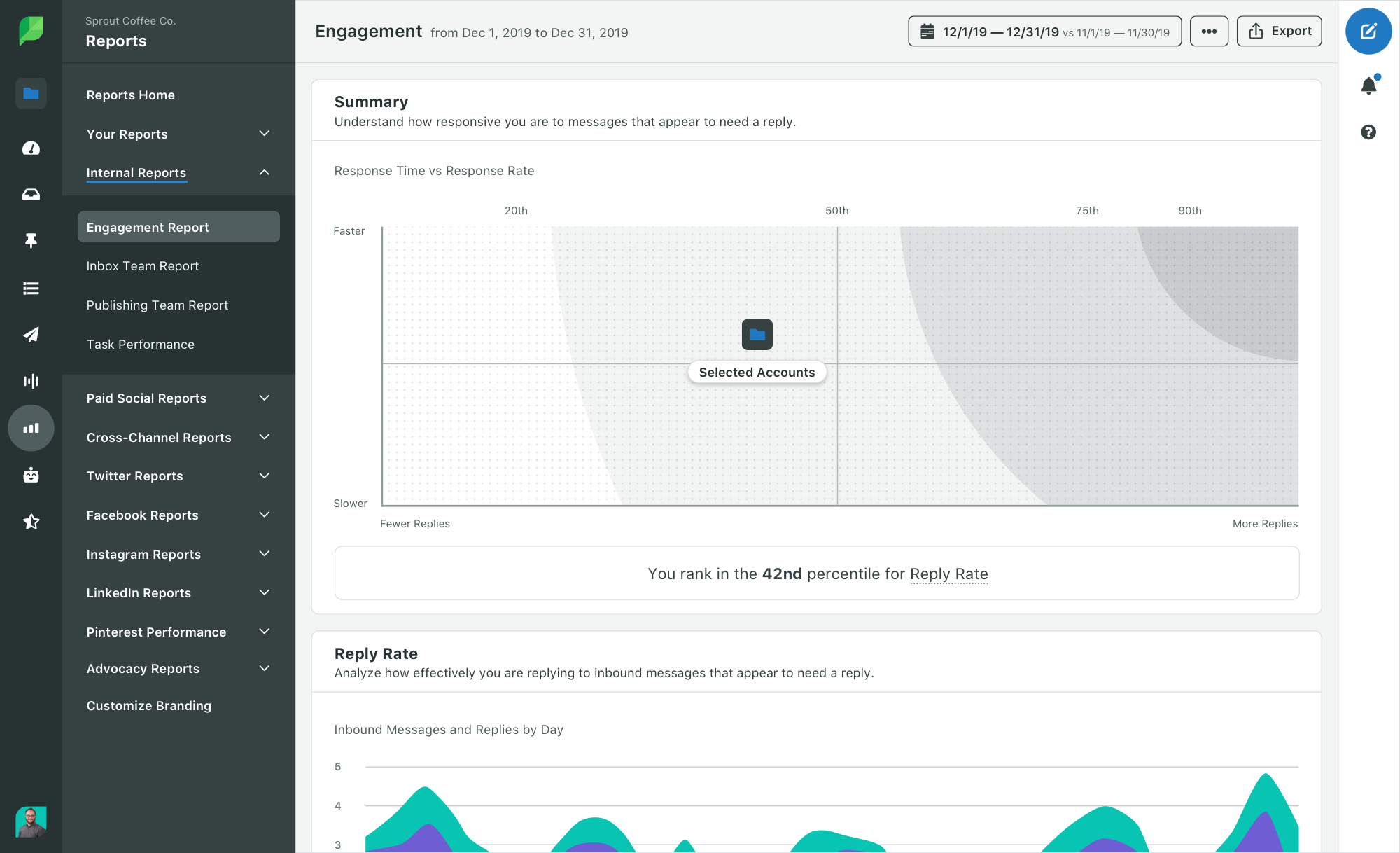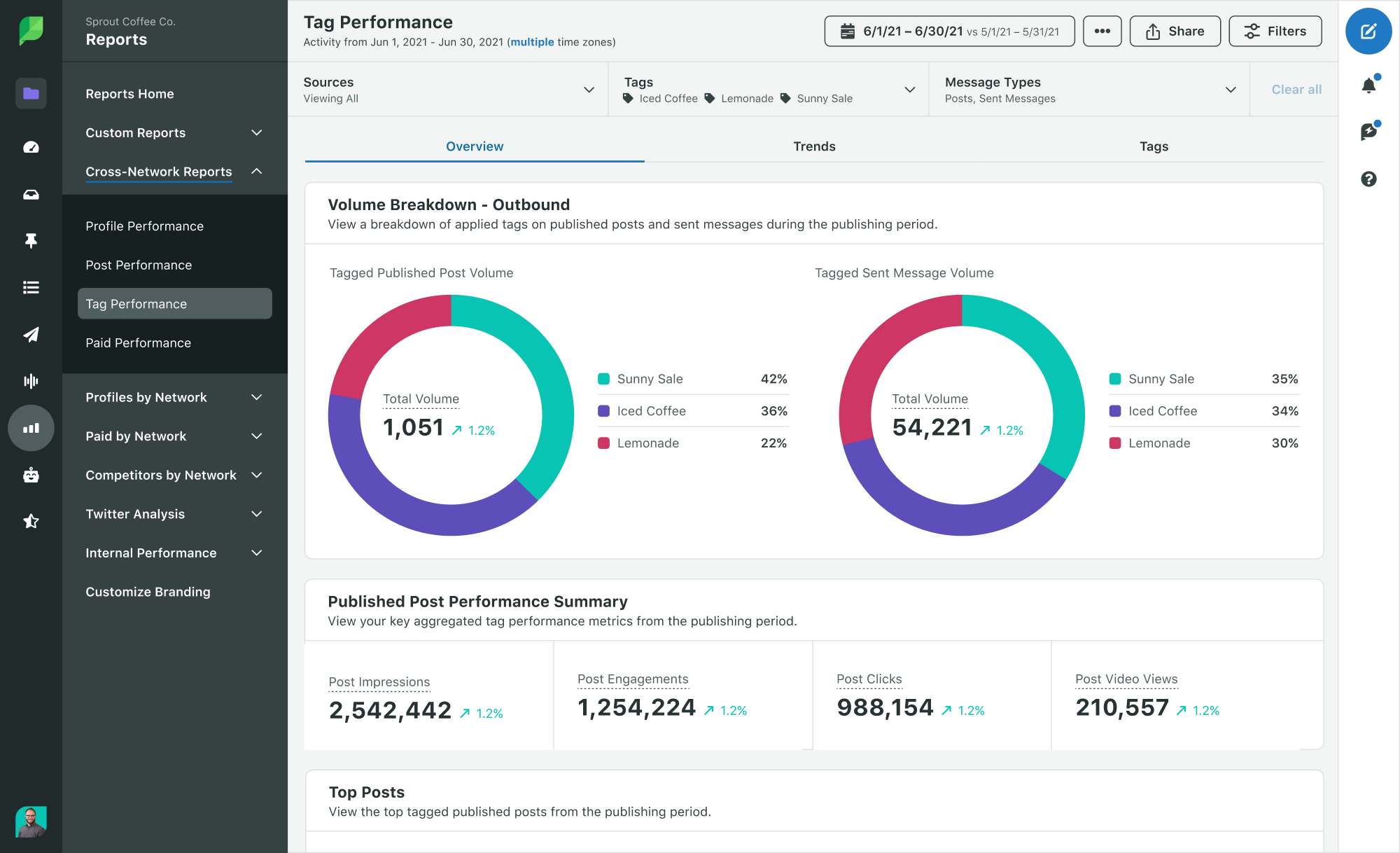It’s no longer enough to respond only to @mentions of your brand online. If that’s all you’re keeping an eye on, you’re most likely missing a variety of messages that only mention your brand by a variation of your name or shout out a product. On top of that, it certainly gets time consuming to switch between so many separate apps to make sure you’re on top of it all. If you find yourself spending more time switching between networks and running complex manual searches for mentions than interacting with brand mentions, then you’re in need of a social media monitoring strategy.
A successful social media monitoring strategy will help you streamline all of your brand’s mentions and search parameters into one place so you focus your time on responding to important messages and developing a strategy from your insights. Your monitoring approach should start with listing everything you want to keep track of and how you’ll be responding to those messages.
Social monitoring is an essential part of any social customer care strategy. It can lead to faster response times, PR crisis prevention and identification of brand advocates. Responding to customers has been shown to lead to stronger brand loyalty among customers.
What is social media monitoring?
Social media monitoring entails keeping an eye on your brand’s mentions online and responding to any engagement around it. It’s an immediately reactive strategy and pertains to all kinds of talk about your brand: reviews, product questions and even service repair complaints.
More importantly, social media monitoring is not only about direct mentions or comments on your posts. It extends out to posts that write about your brand without tagging you. These kinds of posts don’t come up in your regular network notifications, which is why it’s important to set up your monitoring tools.
Monitoring is different from listening. When you monitor, you respond accordingly. But when you practice social media listening, you’re taking an overall look at brand mentions and industry trends to better inform future marketing decisions. Both can be extremely valuable to your brand in an individual way–to learn more about listening, check out our comprehensive resources for social media listening.

Monitoring and listening do often partner up in a company’s social strategy. While listening is more proactive and can lead to business-wide insights, it follows a similar process as monitoring and can help uncover important conversations like those untagged mentions. You’re not able to listen without doing the monitoring. While you’re monitoring, you can tag incoming messages that will later on be used to generate listening queries and reports.

The above illustrates the wide spectrum of monitoring that leads to listening. Sprout’s toolkit offers a solution at every part, which leads us to our next point of topic: how can any of this benefit you?
How can social media monitoring benefit you?
The most immediate benefit of social media monitoring is that it makes your customers feel heard and supported. Sprout’s 2019 Index Report found that:
- 59% of consumers reach out to brands on social because they had a great experience
- 47% of consumers reach out to brands on social because they have a product or service question
- 40% of consumers reach out to brands on social because they had a bad experience

Have you ever Tweeted at a company and received radio silence? That must’ve been frustrating and impacted how you now perceive the company, whether or not you realized it at the time. At 78%, the majority of marketers that Sprout surveyed responded to a customer request within 12 hours. When you respond on social media to consumers, they’re 21% more likely to purchase from you. Monitoring helps you with your brand perception and sentiment.
Airlines have some of the busiest social media notifications around and it helps to keep an eye on brand keywords. Because of listening tools, Alaska Airline was able to quickly respond to a customer’s tweets that didn’t directly mention them.
I'm sorry for any trouble! Feel free to DM us if we can assist. -Jordan https://t.co/t4ooDR29zz
— Alaska Airlines (@AlaskaAir) February 5, 2020
Social media monitoring also helps you sort through the noise and lets only the important messages through. Instead of mindlessly scrolling through your Twitter timeline in the hopes of finding a mention of your brand, or repeating time consuming manual searches that may miss variations of brand terms, use a monitoring strategy to alert you whenever your brand is talked about. For situations like key influencers complaining online about your business, a faster response might head off a PR nightmare.
It also helps you keep an eye on brand advocates who you’ll want to interact with. In the below post, Project Juice was tagged on the photo and in the location. Because of this, they were able to comment on their post and interact with someone who has 59k followers on Instagram. If they didn’t know of this influencer before, they do now and can keep them in mind for future marketing campaigns.
Monitoring isn’t only limited to your brand, though. You can use monitoring as part of a competitor analysis: see what people are saying about your competitors and what their top praises and complaints are. When it calls for it, you can step into the conversation and offer your products as an alternative to what they’re using.
How to use Sprout for social media monitoring
The strongest element in Sprout’s toolkit of social media monitoring tools is the unified Smart Inbox. Instead of switching between networks, the Inbox helps you stay focused and reply to what matters.
Within a span of five minutes, you could easily respond to a Twitter mention, an Instagram comment and a Facebook review without leaving the app. All of the networks, brand keywords, search results and hashtag campaigns show up in the real-time Inbox. This all-in-one overview is useful for not just small businesses with an active social media presence but also for large, multi-location or multi-profile corporations.

To use Smart Inbox to its fullest extent, begin by adding brand keywords. These should include all of your regular mentions of your brand names and the misspellings. Next, add in common brand hashtags and any current campaign hashtags.

If applicable, be sure your review sites like TripAdvisor are also connected. You don’t want to miss out on addressing reviews when they were only a quick connection away.

If you’re not using Sprout for monitoring, here’s a list of items that you’ll want your social media monitoring solution to pay attention to:
- Brand name, including common misspellings
- Brand product names
- All mentions, comments, reviews and direct messages
- Reviews across various platforms
- Posts at your location(s)
- Posts that tag you in their photo
- Brand hashtags
- Campaign hashtags
- Industry hashtags, if applicable
- C-suite’s names if they’re active online or an industry thought leader
- All the above repeated for a competitor, depending on how close an eye you want to keep on them
Once you have this all set up, the next step is all about responding quickly and with messages from the correct teams. For large social teams, a group of people will sort through incoming messages and assign to different team areas depending on the content. One team may handle technical service questions while another responds about retail products. This is where Sprout’s Task and Tagging ability comes in handy. You can assign messages to people and tag each message with appropriate keywords.

Another great use of tagging is to associate incoming or outgoing messages with a certain product launch, campaign or other initiative by your brand.

Later on, these tagged messages can easily be pulled into Sprout’s analytics and provide the data will become the data that drives your monitoring reports. You can also go a step further to build listening queries that can inform your decisions on marketing and product development.
Analyze your social media monitoring
So now that you’ve put all this effort into loading search parameters and responding to all your brand-associated messages, what’s next? Are your efforts paying off?
The internal Engagement Report benchmarks how well your company is doing against similar companies in reply rate. It also documents how quickly you respond on any given day. Based on key elements like message with questions requiring a response, Sprout also identifies which messages are important for you and reports how many of them were responded to.

Do you have a large team? Reports like the Team Report help you see how quickly your team is responding, broken down by team member.

Both of these reports help you understand where you can improve, whether it’s response rate or response time or both. You’ll be able to benchmark your current response times and set goals for better ones.
In addition to internal team performance, social monitoring can also help you understand how different types of content and campaigns are performing. Those messages that you relentlessly tagged earlier? They can be filtered into the Cross-Channel Tag Report to easily view what impressions, engagements and clicks were involved.

With reports like these, you’ll be able to easily see what is most talked about and if a social campaign performed well. You won’t need to manually separate out the messages that were part of a campaign in order to compare its success to your standard social content. Tagged campaign messages no longer need to be sorted through. With tags and a click of a button, the report is easily generated and your campaign results produced.
Conclusion
Social media monitoring involves the tracking of online brand mentions and the subsequent responding of them. Monitoring keeps your brand on top of messages before they might become viral for the wrong reasons. They also help you maintain a positive brand image among consumers and identify potential influencers.
When choosing the right monitoring tool for you, you want it to cover all the networks that you’re presently on and hopefully all in one space. With less back and forth between apps and browser tabs, you’ll be able to focus more clearly on the task at hand: focusing solely on social customer care and maximizing the value of your campaigns.
Are you ready to take on a social media monitoring strategy for your brand? Sign up for a free trial of Sprout Social today.
This post Why brands need a social media monitoring strategy originally appeared on Sprout Social.
from Sprout Social https://ift.tt/2w54bzo
Do You Know You Can Buy Instagram Followers from SocialKingMaker.com?
No comments:
Post a Comment